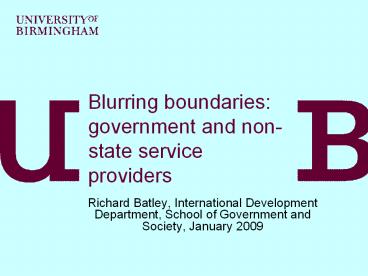Blurring boundaries: government and non-state service providers - PowerPoint PPT Presentation
1 / 15
Title:
Blurring boundaries: government and non-state service providers
Description:
Blurring boundaries: government and non-state service providers ... Health: no serous claim to universality. W&S: public formal, private informal ... – PowerPoint PPT presentation
Number of Views:97
Avg rating:3.0/5.0
Title: Blurring boundaries: government and non-state service providers
1
Blurring boundaries government and non-state
service providers
- Richard Batley, International Development
Department, School of Government and Society,
January 2009
2
Field of study
- Governments relations with non state providers
of services - NSPs NGOs, VOs, CBOs, FBOs, and for-profit
organizations - Primary education/health, basic sanitation
- Pakistan, Bangladesh, India, Nigeria, Malawi,
South Africa - http//www.idd.bham.ac.uk/research/Service_Provide
rs.shtml
3
Scale of provision
- Lack of systematic data NGOs a small part of
total except in Bdesh - Except in RSA, NSPs are important.
- Africa
- Mission hospitals and schools
- Nigeria 60 use private and traditional health
care - Unregistered schools 40 of children in Lagos
- South Asia
- Predominance of private medical practice
- Registered and unregistered schools
- Majority depend on private water and sanitation
- Health and education NSP often the preferred
provider
4
1. The DFID NSP study
- Can governments work constructively with NSPs,
and what role may donors have in supporting this? - Policy dialogue, regulation, facilitation,
contracting. - India, Pakistan, Bangladesh, South Africa,
Malawi, Nigeria.
5
Policy environment Is there a compact?
- Formal espousal of partnership
- History of policy instability and mistrust
- Takeover, suppression, state failure,
re-emergence, partnership - Constant shift in rules of the game
- Education state asserts dominance
- Health no serous claim to universality
- WS public formal, private informal
6
Partnership a new archetype?
- Wide acceptance in principle
- Donors the common factor
- Country dynamics
- Rivalry and mistrust Government loss of control?
NSP loss of independence? - NGOs advocate or deliver services - with or
without government?
7
Policy dialogue
- Formal dialogue to promote partnership
- On policy design, not implementation
- Dominated by large NGOs and advocacy groups
- Little participation of small and for-profit NSPs
- Informal dialogue in implementation
- Building trust and doing deals
- Positive and negative cases
8
2. The NGPA project managing the relationship
- How do partnerships operate?
- Focus on relationship of NGOs with government
- Different means and ends of public action
- NGOs that directly support government services
- Is collaboration possible without loss of NGPA?
- Question assumptions partnership or subordination
9
Stages of research
- India, Pakistan and Bangladesh
- History of govt/NGO relations,
- Study of 3 sector programme areas
- In-depth case studies
- Return to levels 1 and 2 test broader relevance
of case findings
10
Programme areas
- Education Improvement of government primary
schools by NGOs, and NGO provision for hard to
reach children - Health Management of government basic health
units by NGOs - Sanitation Collaboration of NGOs with government
in community sanitation programmes
11
Findings Subordination of NGOs?
- Increased formalization of agreements
- Most agreements are formally vertical
- Do these lead to subordination of NGOs?
- Yes, under some circumstances UPHCP Bangladesh
- Historically independent sectors now being pushed
into partnership - Directive policy to contract out PHC, funded
by donors through government - Classical, formal contracts and competitive
tendering rigid application - NGOs options Adapt or not engage
12
Findings NGOs do influence policy and practice
- Orangi Pilot Project resists ADB investment and
promotes component sharing - Karuna Trust makes policy for contracting out
PHC, at state and national level - FIVDB Part of national campaign for policy on
CLTS - Door Step School influences practice for hard to
reach children - Shelter Associates increases responsiveness of
local government to slum communities
13
Explanation 1Structural conditions
- Country and policy contexts differ levels of
centralism, donor influence, govt support for
NGOs, elite networks. - More influence where
- Policy is less directed by donors and more
malleable, and relationships more locally
negotiated - Agreements are mutual with NGO independently
funded - Agreements have a strong relational element
- Agreements evolve from informal contacts not from
competitive tendering
14
Explanation 2 NGO strategies to manage resource
dependence
- Dependence Policy authority and financial
control - Adapt as a defensive strategy or by choice
- Shape the relationship, using role as knowledge
brokers, selling new approaches to collaboration - Avoid dependence by reliance on own resources or
on multiple funders, and asserting own terms
15
Explanation 3 Cultivating insider influence
- Base influence on technical skills, proximity to
community and funders, awareness of international
discourse - Avoid open confrontation, cultivate relations,
give credit following the normal channels and
avoiding offence - Use insider understanding of rules and
constraints to explain and influence change,
without forcing open concession - Employ soft lobbying versus hard advocacy voice
with loyalty.































